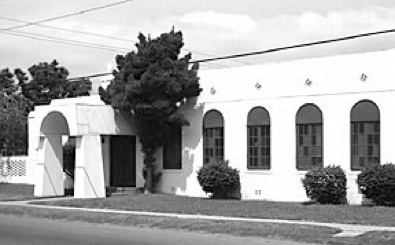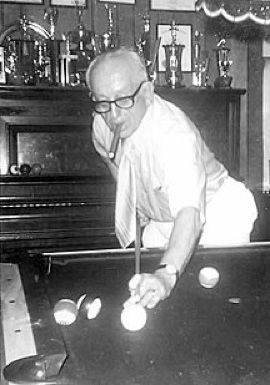

The Jews of Brownsville, especially parents concerned for the Jewish upbringing of their children, desired a synagogue building of their own. Without a regular Hebrew service, some Brownsville Jews had taken up the habit of attending services at the Episcopal or Catholic church. A group of Jewish women led this organizing effort, establishing a sisterhood in 1931. Around the same time, a congregation, Temple Beth-El was founded. The sisterhood raised money and purchased land for the construction of a synecause the land was deemed unsuitable. A new tract of land was purchased in 1981, though an economic recession delayed the project. Thanks to a 1983 bequest for a new Sunday School from Morris and Mae Rose Weil Stein, in honor of their son Lewis, a former Hebrew School teacher who was killed during World War II, a new synagogue was constructed in 1989.
Even before the construction of the synagogue, Brownsville’s Jewish community had strong internal leadership. From 1926 until the 1970s, clothing merchant and community member Sam Perl led Friday night services and served as Lay-rabbi for the Brownsville community. Perl functioned as an ordained rabbi would, officiating at various lifecycle events. Recognizing the diversity of his congregation, with a mix of orthodox, conservative, and reform Jews from Europe, Latin America, and across the United States, Perl took a religious approach that would satisfy as many congregants as possible though he nonetheless remained open to change. For example, throughout World War II, Temple Beth-El welcomed Jewish servicemen stationed near Brownsville. However, many of these soldiers had backgrounds rooted in more traditional Judaism; in order to suit their request that Hebrew be incorporated into the service, a soldier began sharing the bimah with Perl, who began, at the soldiers’ request, to wear a tallit (traditional prayer shawl) and kippah (traditional head covering) while leading the service. When the soldiers returned home, the service returned to an English-only format, but Perl continued to wear the prayer garments provided by the Jewish Welfare Board.
The Jews of Brownsville, especially parents concerned for the Jewish upbringing of their children, desired a synagogue building of their own. Without a regular Hebrew service, some Brownsville Jews had taken up the habit of attending services at the Episcopal or Catholic church. A group of Jewish women led this organizing effort, establishing a sisterhood in 1931. Around the same time, a congregation, Temple Beth-El was founded. The sisterhood raised money and purchased land for the construction of a synagogue, which was completed by 1932.
Ruben Edelstein played a key role in putting Temple Beth-El on a strong financial footing, gaining tax-exempt status for the congregation. When the cemetery fell into disrepair, Edelstein was appointed to oversee the burial ground. Edelstein also served as assistant Lay-Rabbi from the 1950s until 1975, and later served as temple president. Thanks to Edelstein’s leadership, when two lots adjacent to the synagogue became available in 1955, the congregation was able to purchase both and construct a new religious school building in 1956, completing it three months before Temple Beth-El’s 25th anniversary. Edelstein was also a leader in the larger community, serving as mayor from 1975 to 1979.
Soon after the new religious school opened, the Jewish population of Brownsville grew dramatically. Temple Beth-El’s membership had fluctuated in the 1950s, from a low of 35 families to a high of 52 families. During the 1960s, membership grew to 65 families, including 50 children in the religious school. The increase continued into the 1970s; by 1975, Temple Beth-El’s membership reached 100 families. The Brownsville/Matamoros region was booming with industrial economic development, which likely explains the steady growth of the Jewish community at the time.”
Temple Beth-El’s growth meant that hiring a full-time rabbi, was now an attainable goal. However, out of deference to lay-rabbi Perl, the congregation chose to seek out only a “Director of Education” who also happened to be a rabbi. The congregation soon realized that without affiliating with a specific branch of Judaism, they would be unable to attract a suitable candidate. For its first forty years, Temple Beth-El, in order to avoid conflict among its diverse congregants, had purposefully avoided formally affiliating with one branch of Judaism. But since affiliation proved to be a prerequisite for hiring an ordained rabbi, Temple Beth-El joined the Union of American Hebrew Congregations, the national organization of Reform Judaism, in 1973. Harry Lawrence became Temple Beth-El’s Director of Education. Lawrence became the official rabbi in 1973 when Sam Perl resigned as Lay-Rabbi due to health problems.
Perl had successfully served as a unifying presence among the diverse congregants, though some of his successors were unable to handle the complicated balance among denominations. Rabbi Jonathan Gerard (1976-79) sought a greater role for women during the prayer service; Orthodox members were upset and considered forming a new congregation. The uprising was quelled due to a lack of community and financial support; Gerard’s successor, Rabbi Matthew Michaels (1979 – ???) helped calm the waters. Temple Beth-El celebrated its fiftieth anniversary in 1981 and in recognition of Beth-El’s longevity Brownsville’s Mayor Emilio Hernandez declared August 31st, 1981 to be “Temple Beth-El Day.”
Even though the congregation had renovated its sanctuary in 1960s, they soon began to discuss building a new synagogue to accommodate their tremendous growth. In 1972, the congregation purchased a plot of land, but resold it due to financial concerns and because the land was deemed unsuitable. A new tract of land was purchased in 1981, though an economic recession delayed the project. Thanks to a 1983 bequest for a new Sunday School from Morris and Mae Rose Weil Stein, in honor of their son Lewis, a former Hebrew School teacher who was killed during World War II, a new synagogue was constructed in 1989.
In his 1876 letter to the editor of The American Israelite, future Brownsville mayor and then-acting-postmaster Benjamin Kowalski reported on the progress of the small Jewish community on the edge of the south Texas frontier. He concluded his letter with the hope that he had “shown the outside world that there is a small spot in Texas called Brownsville where Jews and Judaism still wave.” Through the vicissitudes of almost 170 years of history, Kowalski’s words still ring true today.
Full Brownsville Jewish History link